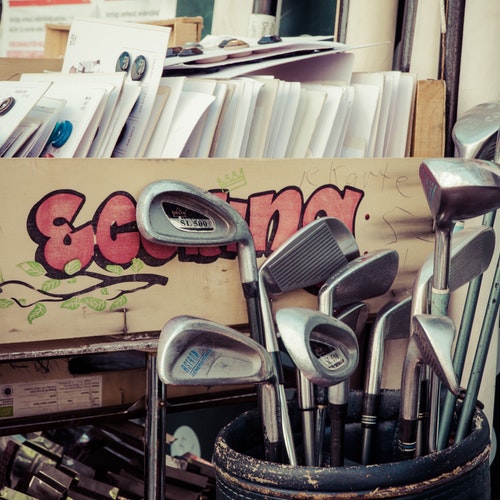Share this!
 By: Brian Neufeld, GolfTourney.com Contributor
By: Brian Neufeld, GolfTourney.com Contributor
As we covered in our last post, buying new clubs is a serious undertaking. Buying a new set of irons or a new driver will set you back a lot of money and, much like other pieces of technology, the latest and greatest golf tech seems to come out every time you turn around. That smartphone you bought two years ago? It’s already as outdated as the flip phone your father still uses. By the time you finish researching and testing the newest clubs, there’s likely to be a new set with improved technology coming out shortly after.
The right answer to how often should you replace your clubs is totally dependent on the individual. In a general sense, every five years is the number to shoot for just to keep up with changes in technology. Newer clubs tend to be more forgiving and will help your overall game. If you’re a casual player who only sees the course a few times per season, you can probably stretch it out a bit longer. Today we will take a deeper look at what to think about when shopping for a new set of irons or a putter.
Your Swing is the Only One That Matters
As we discussed last time, too many of us get caught up in brand names of our clubs instead of trying to find the right fit. Seek out as many brand names as you can to find the perfect club for your shot. Several factors are to be considered in finding the perfect set of irons. Most notable is the style of irons you prefer to use. Cavity-backed irons have been instrumental in helping higher handicap players find success on the course and this is what the majority of us should be using. Cavity-backed irons are extremely forgiving and help suppress the loft of shots as amateurs tend to have much higher ball flights than the pros. Muscle-backed irons, or more commonly blades, provide increased shot-shaping capabilities but are extremely unforgiving and aren’t made for the average golfer.
Make the Switch to Hybrids
Hybrid clubs stormed onto the scene with TaylorMade’s Rescue series in the early 2000s and have only gained in popularity since. However, most sets of irons on the market today still start off with a 3 or 4-iron. Eventually, club manufacturers will catch up with the times and these irons will go the way of the 2-iron but until then it’s up to you to phase them out. If you can’t find a set of irons that start at the 5-iron and give you an increased number of wedges, you’ll have to make the swap yourself. Hitting a pure shot with a 3-iron or 4-iron is a very difficult task, and with today’s hybrid options it’s a fool’s errand. When swapping out these irons in favor of the more forgiving hybrids, be sure to match distance exactly or you’ll find yourself with a yardage gap in your club selection. One extra benefit of this switch is the increased number of wedges. Having these different lofts around the green will provide an instant benefit to your short game.
Customization is Key
Many of us have long viewed club customization as something meant for the best golfers on the planet and nobody else. This could not be further from the truth. Brooks Koepka could beat an amateur golfer with the oldest set of clubs on the planet just with his raw, natural ability. High handicap golfers without that natural talent must take advantage of all that’s available to them. As we suggested in our last post, get with your local head pro to do a club fitting session. After you’ve found the right set of irons, it’s imperative to get the proper shafts installed. Very rarely does the stock shaft match the amateurs game. Finding the right grip for you can also significantly improve the performance of those new clubs as well.
Putters Break the Mold
Unlike drivers and irons, putters are in a world all their own. Brandt Snedeker’s putter is over 10 years old. Charles Howell III uses the same model putter that he used in college. Jordan Spieth’s putter is so aged it has rust on it. Finding the right putter for you basically boils down to one key factor. The sole of the putter must be parallel to the ground through your stroke. Without this, your tendency to mishit the ball skyrockets and you’ll miss putts you otherwise would not. This is not to say some new putters can’t improve your game. Increased sweet spots and better physics with new putters could be the answer to your struggles on the green, it’s just a matter of testing.
One thing putters do have in common with our other clubs is finding the right grip matters. Fat grips burst onto the scene years ago and have been invaluable for the amateur and professional alike. Try to find a putter similar in style to your current one that has a fat grip before regripping your current putter. Use it as many times as possible before making the switch. You may find this simple switch can shed strokes from your score.
As with any piece of golf equipment, the right choice is solely dependent on you, the golfer. Unless Tiger Woods is your neighbor and always forgets his clubs when he plays with you, there’s no need to buy the same irons he uses just because. Spending time researching the newest technologies is valuable, but nothing beats holding the clubs yourself and taking them for a spin. Hit as many demo days as you can before dropping the money on a new set, and try to involve your local pro as much as possible in the decision. They can not only point you in the right direction but also help you customize your clubs to fit your game perfectly. With these posts, you can start the process of making the switch and improving your game in the new decade.
About the Author: Brian Neufeld
Brian Neufeld’s background includes more than 15 years of experience in golf course management, specializing in agronomy. Brian uses his knowledge of the game and best practices in turf sustention to create informative pieces for GolfTourney.com’s readers.
Share this!


